When Airbus first set out back in 2004 to develop a new widebody under the A350 designation, it originally posited an upgraded version of the existing A330 twinjet. Having taken aim at the then-new Boeing 787, Airbus quickly realised that this derivative programme would be handicapped in the race against the Dreamliner – and went back to the drawing board.
Airbus regrouped to make a broader assault on the Boeing widebody line-up. At Farnborough 2006 it launched the clean-sheet A350 XWB family as a counter both to the 787 and to the established 777 family. This three-pronged family sported an enlarged fuselage cross-section fully 12.7cm (5in) wider than the 787 – hence the Xtra Wide Body tagline – as well as extensive use of composite materials (54% of the primary structure) and all-new Rolls-Royce Trent XWB engines.
The baseline 325-seat A350-900 received European and US certification in the fourth quarter of 2014, and to date 173 examples of the -900 version have been delivered. The smaller variant, the -800, was shelved as Airbus focused on the development of the -1000 stretch. This larger variant was a crucial development. Not only does it bridge the gap between the A350-900 and the 550-seat A380 double-decker, but it also provides Toulouse with a direct competitor in the segment where Boeing has enjoyed significant success with the 777-300ER. And Airbus is adamant that its all-new design will ensure the A350-1000 exceeds the 777-300ER’s capabilities with markedly lower cash operating costs.
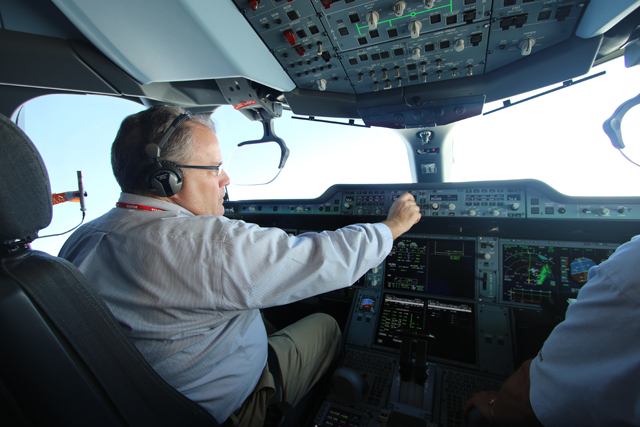
Max Kingsley-Jones/FlightGlobal
Stretching or shrinking an existing model is a well-worn strategy to cover additional segments while leveraging development investment. The A350-1000 incorporates 7m (23ft) stretch through fore and aft fuselage plugs, which gains an additional 40 seats over the -900 in a typical layout.
The flexibility to up- or down-scale equipment on a city pair is appreciated by airline route planners. So, to retain the same 8,000nm (14,800km) range capability as its smaller sibling, the -1000’s weights, wing area and engine thrust were increased accordingly.
A key change from the A350-900 involves the wing. To allow the A350-1000 to fit in the same Type E airport gate as the A350-900 and the A330, it has the same 64.75m span as the A350-900. However, the wing area was increased to handle the higher weights. The A350-1000 has the same wing box as the A350-900 but the overall chord is extended through an approximately 30cm (12in) extension to the inboard sections of the fixed trailing edge.
CRUISE CONTROL
This gained an additional 22.3m2 (240ft2) of wing area. Wing loading is a metric that helps define an aircraft’s characteristics. At maximum take-off weight, the A350-900 has a wing loading of approximately 633.3kg/m2 (129.7lb/ft2), while the larger A350-1000’s is about 7% higher at 680.3kg/m2.
In general, the higher the wing loading the faster the cruise speed of an aircraft. One unique feature of the XWB family is its morphing wing. Flight computers tweak the position of the inboard and outboard flaps (+/-4°) during all phases of flight. This capability gives the A350 a variable-camber wing that can be optimised for real-time flight conditions, especially useful for the hours-long cruise portion of the flight. Though not confirmed by Airbus, both the models cruise at Mach 0.85 so it can be assumed that the A350-1000’s morphing wing has a higher camber in cruise than the A350-900’s.
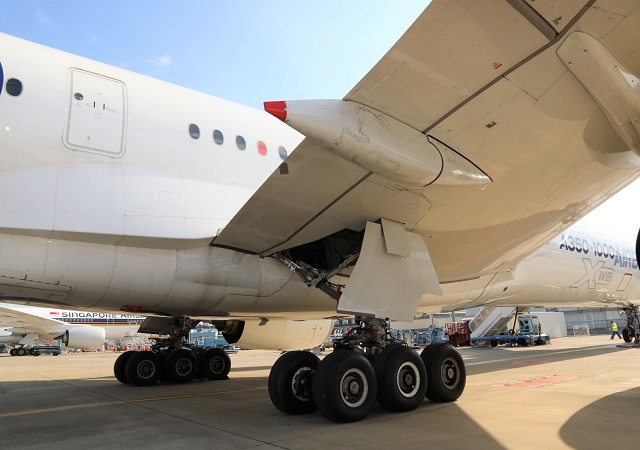
Max Kingsley-Jones/FlightGlobal
The highest maximum take-off weight currently offered by the -1000 is 316t, 36t greater than the heaviest -900 (the ULR). The -1000’s increased weights drove Airbus to install a six-wheel bogie main gear (above), just like the rival 777. The bigger gear trucks required the wheel well to be expanded by one frame. This and the increased wing chord prompted Airbus to move door 3 (located behind the trailing edge) back by one frame. Overall, the A350-1000’s extra structure adds just over 13t to that of the A350-900.

Touchscreen displays are being trialled in the A350-1000 test aircraft
Max Kingsley-Jones/FlightGlobal
Airbus markets both the basic A350-900 and A350-1000 with a nominal range of around 8,000nm. The heavier aircraft will burn more fuel, with the A350-1000 needing a 14t (around 18,000l) capacity boost over the standard A350-900. The XWB’s fuel system comprises two main tanks – one in each wing – and a centre tank. The A350-1000 has the same capacity centre tank as the A350-900; remarkably, space for the extra tankage already existed.
According to A350 marketing director François Obé, the only notable changes needed to increase fuel capacity were to the fuel quantity-sensing system. This resident extra fuel tankage capacity is also used in the A350-900ULR model, which sports a range of up to 9,700nm.
The A350-1000 is powered by the Trent XWB-97, a more powerful version of the Trent XWB-84 that powers the A350-900. Notably the more powerful 97,000lb-thrust (432kN) engine retains the same 3m (118in) diameter fan and nacelle as the 84,000lb-thrust model. The large thrust bump is gained by a slight upsizing of the core and running it at higher temperature, which in turn allows the redesigned fan to turn at higher speed.
According to the Type Certificate Data Sheet for the Trent XWB series engines, fan speed of the XWB-97 at maximum continuous thrust is nearly 6% faster than the XWB-84’s. The higher rotational forces do require thickened titanium fan blades for the XWB-97 model.
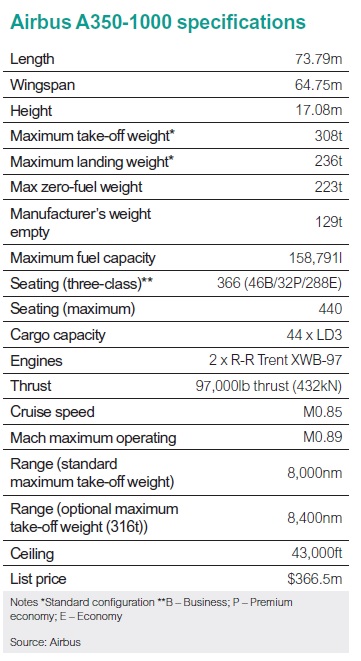
A year after its first flight on 24 November 2016, the A350-1000 received joint European and US certification following a 1,600 flight-hour test programme involving three aircraft. The A350-1000 entered revenue service in February 2018 with launch operator Qatar Airways. To date, Airbus has secured orders for 168 aircraft from 11 customers.
In June, as Airbus began A350-1000 deliveries to its second operator, Cathay Pacific, FlightGlobal was in Toulouse to find out how the stretched XWB handled. The host for my preview flight was senior experimental test pilot Peter Chandler, who also guided me through my A350-900 flight three years ago.
FLIGHTDECK FAMILIARISATION
Our preview aircraft was the first A350-1000 (MSN059, F-WMIL), which has an unfurnished interior incorporating test equipment and engineer stations. Once on the flightdeck, Chandler highlighted some of its new features. When I flew the A350-900 I found its flightdeck to be “Airbus’s cleanest to date, featuring six large displays”. Visually the A350-1000’s cockpit is identical, with the exception of an “Emer Descent” switch on the pedestal-mounted speed brake panel. One other hardware change is the incorporation of several touchscreens in place of the standard 15in displays. While not installed in the preview aircraft, Airbus is also considering offering an optional synthetic vision system for the primary flight display.
Prior to engine start, Chandler showed the utility of the touchscreen displays that are currently under test on MSN059. He placed the onboard information system (OIS) window on the bottom centre touchscreen display. The touchscreen allowed both pilots to enter and retrieve data at the same time, easing workflow. Additionally the touchscreens can be pinched and zoomed with two fingers, just like a mobile or tablet device.

Max Kingsley-Jones/FlightGlobal
Chandler also demonstrated the OIS’s dispatch page, which consolidated all the applicable minimum equipment list items onto a single page. With a mere touch of the screen, procedural changes and limitations were displayed for easy reference. Once airborne the dispatch page is accessible, but no alerts will be triggered for new items as the aircraft will already have been “dispatched”. Finally Chandler demonstrated the safety-enhancing features of the take-off surveillance system. On the flight management system (FMS) performance page he entered take-off speeds, deliberately entering too low a value for V2. The low V2 triggered “T.O Speed Too Low, Check TOW & T.O Data” and “V1 VR V2 Disagree” messages. Early warning of suspect take-off data may well prevent an incident or accident on take-off roll.
During the engine start sequence, time from start initiation to idle on each engine was only 1min – noticeably shorter than that required for new-generation CFM Leap and Pratt & Whitney PW1000G engines that power narrowbody types.
The A350-1000 has several additional features designed to prevent unsafe take-offs. During the taxi to Toulouse-Blagnac’s runway 32L for take-off, Chandler briefly advanced the thrust levers to the “CLB” detent. Sensing that we were not on a runway, a “Nav On Taxiway” caution message was displayed to alert us we were not in a take-off position.
Approaching the runway, Chandler entered a take-off shift of 3,000m (9,840ft) into the FMS performance page, signifying we would start the take-off roll further down the runway than planned. Sensing the unsafe condition, the FMS displayed a “T.O RWY Too Short” message. Finally, to trigger the last demonstrated safety feature, Chandler had deliberately loaded the parallel runway (32R) into the FMS, not our planned one (32L). Once cleared for take-off and thrust levers advanced, a “Not On FMS RWY” message was displayed. Chandler cancelled the warning, as we were indeed on the planned runway.
After take-off the A350-1000 was turned to the south and climbed into an intermediate altitude block, flight level 100-150 (10,000-15,000ft). Airbus has developed a new high-speed protection mode, which does not change the flightpath to control speed. With the thrust levers in the CLB detent and autothrust disengaged, a descent was started and the aircraft accelerated to the VMO (maximum operating Mach) of 340kt indicated air speed (KIAS). At 345KIAS the autothrust “woke up” and retarded the power to idle. Simultaneously the speedbrakes were automatically extended to slow the Airbus below 340KIAS.
SAFETY FEATURE
Next, a new slow speed protection mode was demonstrated. With the autopilot engaged in altitude hold (ALT) and heading (HDG) modes, the thrust levers were retarded to idle (autothrust disengaged) and the aircraft allowed to slow past the lowest selectable speed – VLS (173KIAS) – to Alpha Floor speed (163KIAS for current conditions).
Once slowed “Speed, Speed” was enunciated. Rather than descending to accelerate to a safe speed, the autothrust engaged up and accelerated the aircraft past VLS, where it automatically disconnected. This automatic disconnection of the autothrust represents a change from previous slow-speed protection modes. Once a safe flight condition is attained, the automation bows out and returns the aircraft to the pilot in the same automation state existing before the slow speed excursion.
After the slow-speed demonstrations were complete, we climbed to FL350 and established a M0.85 cruise condition. This point was held for 5min, Airbus gathering data for an in-service issue related to the wing’s leading-edge droop nose seals. During the lull, I noted the cabin altitude was only 5,250ft with a differential pressure of 0.60bar (8.7psi). The A350 has a 0.65bar Delta p system which provides a cabin altitude of only 6,000ft, on par with the 787, when at its ceiling.
Modern cabin pressurisation systems are essentially automatic and seldom require pilot intervention. When there is a failure, timely aircrew response is critical. Loss of cabin pressure has been causal in several accidents, perhaps most notably the Helios Airways crash in 2005. Several business jet manufacturers have addressed this by adding an automatic emergency descent mode, but until now there has been no corresponding response by either Airbus or Boeing.
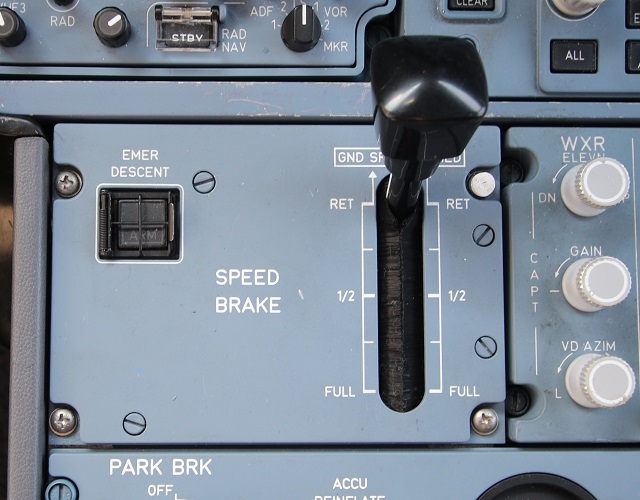
With the A350-1000, Airbus now offers the Automatic Emergency Descent (AED) mode designed to expeditiously descend the aircraft to a safe altitude in the event of cabin depressurisation. In the A350 it can be entered either automatically or initiated by the aircrew (above). In either instance the aircraft will retard thrust to idle and extend the speed brakes, after a short delay. The aircraft will pitch down and accelerate to and maintain VMO/MMO. Simultaneously the aircraft turns off course and establishes an offset track 3nm to the right of the initial track. Left to its own devices the aircraft will be levelled at 10,000ft or minimum off-route altitude (MORA) plus approximately 5,000ft, whichever is higher. Automatic initiation occurs 15s after an excessive cabin altitude is reached, which would be above 14,000ft (unless operating out of high-altitude airports).
For my preview flight we would enter the AED mode manually. The guard on the Emer Descent switch was raised, with the mode armed by depressing the switch. On Chandler’s command I extended the speed brakes to their full position, engaging the mode. I sat back and calmly watched as the A350-1000 turned off course and entered into a maximum speed emergency descent. Descent rates in excess of 8,000ft/min (40.6m/s) were noted, with the aircraft levelling at FL182 (MORA 13,200ft).
In my career I have only experienced one real rapid depressurisation. It was on a maintenance diagnostic flight, and we were well aware that a such an event might occur. Yet when there was a loud swooshing sound accompanied by fogging and a rapid decease in temperature, it took me by surprise. The AED mode offered in the A350-1000 is a great enhancement to safety, easing the workload for an attentive aircrew and perhaps saving an aircrew taken totally unawares.
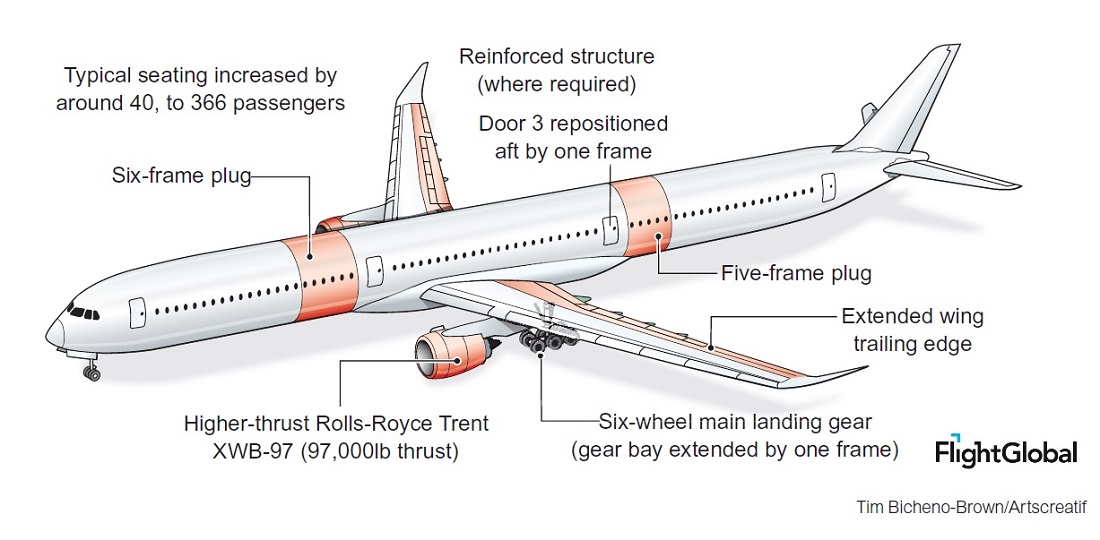 Once in the intermediate altitude block after completion of the AED exercise, I hand-flew the A350-1000. For the most part the larger XWB retains the same flight control laws as the A350-900. As I had found on my earlier A350-900 flight, the A350-1000 demonstrated smooth and predictable handling qualities.
Once in the intermediate altitude block after completion of the AED exercise, I hand-flew the A350-1000. For the most part the larger XWB retains the same flight control laws as the A350-900. As I had found on my earlier A350-900 flight, the A350-1000 demonstrated smooth and predictable handling qualities.
After the handling exercises were complete I turned the aircraft towards Toulouse and with Chandler’s help loaded the approach into the FMS. I was more than a bit curious to see how the A350-1000 handled in the traffic pattern, but weather conditions and mission constraints dictated I observe the approach and landing from one of the flight test engineer stations. The landing was a greaser, even though it was that pilot’s first and only landing in an Airbus “big twin”.
COST BENEFITS
Airbus likes to label the A350-1000 a “777-300ER killer”. From a pilot’s perspective, touchscreens and possible synthetic vision system bring capabilities now commonplace on business jets. The AED mode is also a notable safety enhancement. Advanced engines, materials and aerodynamic refinements bring bankable savings to the table.
On a notional route from Tokyo Narita to New York JFK, with like payloads, Airbus posits a 21,732kg (47,911lb) fuel saving for the A350-1000 over the 777-300ER. On the return route, when bucking headwinds, the projected fuel savings are even greater at 24,623kg. Additional saving are realised when lower maintenance costs are factored in, reflecting the newer design, claims Airbus.

Gerzanics was accompanied by Airbus senior experimental test pilot Peter Chandler (left)
Max Kingsley-Jones/FlightGlobal
The lower weight also reduces airport and navigation fees. All told, Airbus says the A350-1000 has a 25% cash operating cost advantage over the Boeing on a 4,000nm segment (with fuel at $2/USgal). Some say cash is king, but total cost has to include capital costs. With the 777-300ER nearing the end of its production run, pricing flexibility will ensure that “big-twin” sales campaigns continue to be a two-horse race. And the -300ER’s successor, the 777X, is waiting in the wings.
Get all the overage from the Farnborough air show on our dedicated event page
Source: Flight International






















